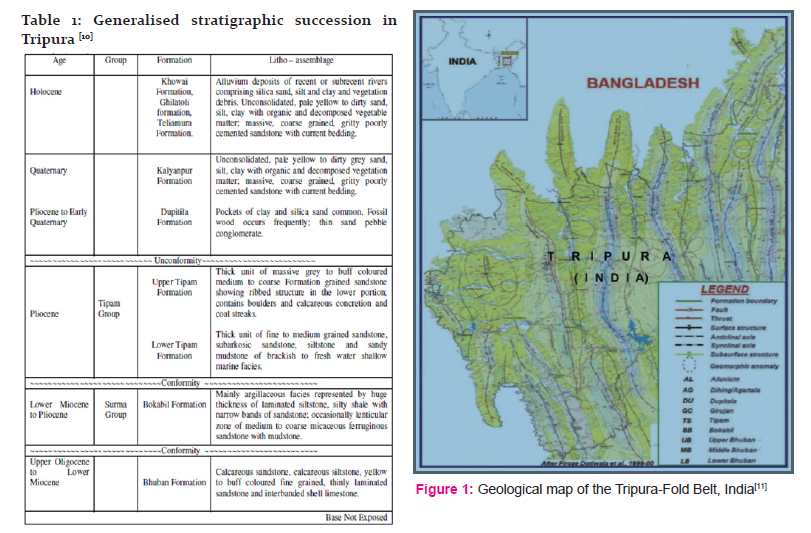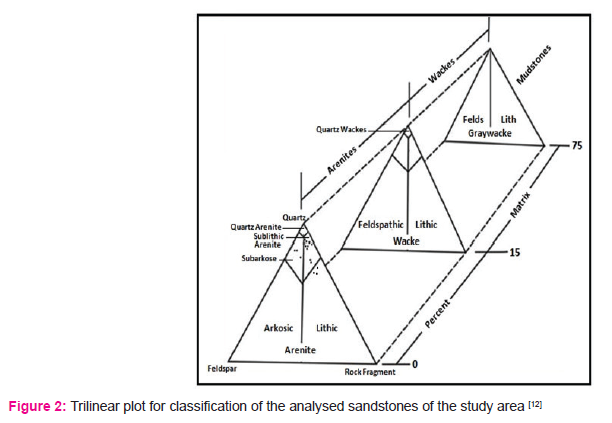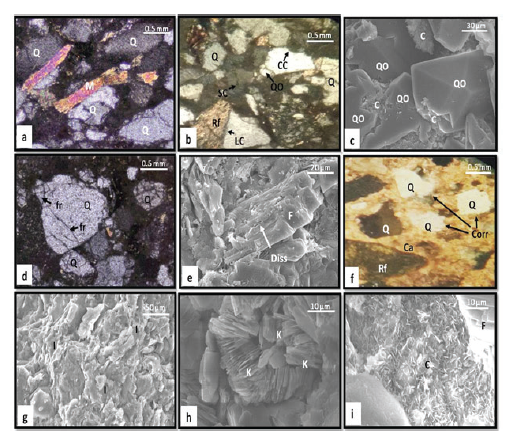IJCRR - 9(11), June, 2017
Pages: 59-63
Date of Publication: 12-Jun-2017
Print Article
Download XML Download PDF
Diagenesis of Sandstones in a Part of the Tichna Structure of Tripura Fold Belt, India
Author: Chayanika Borah
Category: Technology
Abstract:Aim: The aim of the present research work is to study the petrography and diagenesis of the sandstones in a part of the Surma Group of the Tichna field located in the western part of the Tripura Fold Belt.
Methodology: The standard petrographic microscope and Scanning Electron Microscope (SEM) were used for studying the rock thin sections and in identifying the various diagenetic imprints in the sandstones.
Result: The study reveals that the samples are fine to medium grained, sub-angular to sub-rounded, mostly moderately sorted to well sorted and belong to sublithic-arenite, lithic arenite to feldspathic-arenite varieties. Quartz is the dominant mineral in all the samples followed by rock fragments and feldspar. Authigenic clay minerals observed are Illite, Chlorite, Kaolinite and mixed clay types. Important diagenetic changes include compaction, cementation and dissolution of detrital grains.
Discussion: Compaction of the framework grains lead to the development of different type of grain contacts, bending of flexible mica flakes and fracturing of detrital grains. Quartz cementation is observed by the development of euhedral secondary overgrowths of quartz. Authigenic clay minerals either form coating over the detrital grains or occupies the intergranular pores. At restricted depth intervals, calcite cement completely fills the pore spaces. The study shows several detrital grains including quartz, feldspar and lithic grains undergoing dissolution and subsequent replacement either partially or fully.
Conclusion: The analysed sandstones are mostly composed of quartz, rock fragments and feldspar. Compaction effects indicated by bending of mica flakes, grain fracturing, pressure solution and quartz overgrowth; clay authigenesis, cement precipitation, partial dissolution and replacement are the diagenetic signatures observed from thin section and Scanning Electron Microscope analyses.
Keywords: Petrography, Diagenesis, Surma group, Tripura fold belt
Full Text:
INTRODUCTION
Tripura comprises a part of the Frontal Thrust and Fold Belt of the Assam-Arakan Basin. The geological map of Tripura fold belt is shown in Fig. 1. The Tichna structure which is a north-south trending, doubly plunging anticline is located in the western most part of Tripura state. To the North-West of Tichna lies the gas bearing Rokhia structure, in the East & North-East it is surrounded by Baramura, to the South-East lies Gojalia and in the western part it is bordered by Bangladesh. As per the ONGC project report, June 2015 [1], the thickness of the Neogene sediments exposed in the Tichna anticline is approximately 1150m. Bokabil sediments of the Surma Group are the oldest sediment exposed at the core of the anticline, while in the flanks and the plunge part, Tipam and younger sediments are exposed. The generalised stratigraphic succession in Tripura is shown in Table 1. Sandstone properties like mineralogy, grain shape, packing, grain size, sorting, controls the grain-pore relationships and pore–pore throat characteristics [2]. Diagenesis comprises all post-depositional physical, chemical and biological modifications to sediments occurring right from the moment of deposition and continuing through compaction, lithification and beyond [3]. According to Schmid, et al., 2004 [4] and Morad et al., 2010 [5], diagenetic alterations affects the quality and heterogeneity of petroleum reservoirs to a great extent. In this paper, petrographic and diagenetic studies of a part of the Surma Group of the Tichna Structure are being presented. The objective of this study is to acquire an in-depth knowledge of the mineralogical composition, texture and diagenetic history of the sediments.
MATERIALS AND METHODS:
The standard petrographic microscope, scanning electron microscope (SEM) was used in the current study. Fifteen numbers of core and cutting samples (depth range 800 m to 2296m) collected from four wells of the study area were selected for petrographic and diagenetic studies. For petrographic study, rock thin section slides have been prepared by cutting and grinding the samples to a standard 30 mm thickness. A Leica DM 750 P Microscope with Leica DFC 295 digital camera attachment was used for capturing the images of the core and cutting samples studied. For SEM analysis the samples were prepared by removing small freshly fractured rock fragment measuring less than 1 cm diameter. Samples were analyzed using a HITACHI S-3600N Scanning Electron Microscope (SEM) at Oil India Limited, Duliajan, Assam. High resolution SEM images were used for identifying the mineral morphology, authigenic clays and various diagenetic imprints like dissolution effect, quartz overgrowth, etc.
RESULTS:
The studied Surma Group sandstones are fine to medium grained. The framework grains are predominantly sub-angular to sub-rounded and are mostly moderately-sorted to well-sorted. The samples are found to be texturally sub-mature to mature. The framework grains of the investigated Surma Group sandstones are dominated mostly by the stable mineral quartz, with concentrations up to 58%. Feldspar constitutes on an average 6 %. Rock fragments constitutes on an average 13% of the total framework grains. Detrital mica (average 5 %) is also common. Matrix occupies upto 9.1%. A few heavy minerals are also found in minor amounts in the investigated samples. Following Dott’s classification scheme the sandstones are found to be mostly sublithic arenite to sub-feldspathic arenite and lithic-arenite type (Fig.2). The important diagenetic changes of the present study that have been observed from thin section and Scanning Electron Microscope analyses are compaction of the framework grains leading to pressure solution effect, authigenic development of minerals and overgrowths, alteration and replacement of framework grains, precipitation of different types of cements, development of grain contacts, development of intragranular fracture due to differential compaction, etc.
DISCUSSION:
Petrography:
Quartz occurs predominantly as monocrystalline quartz although polycrystalline varieties have also been recorded. Feldspar includes both potassium (K) and plagioclase feldspar. Rock fragments are dominated by metamorphic and sedimentary varieties with rare volcanic grains. Detrital mica consisting of both muscovite and biotite is commonly observed in most of the samples. A few heavy minerals like zircon, tourmaline etc. have been recorded.
Diagenesis:
Compaction and pressure solution: Due to the overburden pressure physical compaction of sediments was initiated which progressively accelerated with increasing depth of burial. Compaction effects of the investigated samples is documented by packing readjustment, plastic deformation of ductile grains, bending of flexible mica flakes (Fig. 3a), deformation of ductile grains and simple and complex fracturing of detrital grains of quartz (Fig. 3d), feldspar and rock fragments. All type of grain contacts are developed due to compaction (Fig. 3b). The straight and long contacts of the framework grains observed in the present study corresponds to the early stage of diagenesis, while the concavo-concave and sutured contacts (developed due to pressure solution, initiated by compaction) represent the relatively later stage of diagenesis [6] . Pressure solution has also led to some quartz cements to be precipitated along siliceous grain boundaries, as quartz overgrowths (Fig. 3b & 3c). In some samples the effect of compaction was ceased by the precipitation of massive calcite. At certain depth, development of pseudomatrix by crushing of soft lithic fragments is observed.
Cementation: Cement is precipitated during burial diagenesis due to changes in temperature, pressure, and ion concentration in pore water. Quartz cementation is observed by the development of euhedral secondary overgrowths of quartz (Fig. 3c) formed in crystallographic continuity with the quartz framework grains. Very often the boundaries between the quartz framework grains and the overgrowths are commonly marked by thin, dust rims of very fine-grained mineral material (mostly iron oxides and clay minerals). In some cases, incomplete quartz overgrowths are seen which is probably due to inhibition by thin, discontinuous chlorite rims. Calcite cement occurs as intergranular pore-filling cement and sometimes tends to be patchy and irregular suggesting complete or partial replacement of the detrital constituents of the sediment. The origin of early poikilotopic calcite cement (Fig. 3f) may be associated with recrystallization of significant amounts of skeletal debris present at the time of deposition of the sands [7]. Development of calcite cement also took place in the intermediate diagenetic stage as indicated by the closer packing of the surrounding grains due to compactional. In some calcite cement dominated samples, the detrital framework grains appear to be floating in the calcite cement (Fig. 3f) which is due to the displacement of grains owing to calcite precipitation. Traces of pyrite identified as black patches in thin sections are observed in a few samples. Under Scanning Electron Microscope, framboidal pyrites (sometimes partly broken) are seen to occur within intergranular pore networks. Iron cements mostly occur as coatings on the detrital grains and over silica and clayey matrix.
Clay authigenesis: In the present study the authigenic clay minerals, as identified from thin section studies and Scanning Electron Microscope analysis are illite, chlorite and kaolinite. Under Scanning Electron Microscope, authigenic illites occur as flake-like platelets within pore spaces or as thin coating around detrital grains (Fig. 3g). In some cases illite-smectite mixed layer clay was also found to form a mat locally over the detrital grains. From Scanning Electron Microscope analysis, kaolinite is recorded in the form of cluster of books with pseudo hexagonal platelets stacked face-to face, locally distributed within the intergranular pores (Fig. 3h). The identified authigenic kaolinite has been interpreted to be an in-situ alteration product of K-feldspar at temperature greater than 100o C [8]. Authigenic chlorites are identified by their typical euhedral and pseudo hexagonal platelets arranged in rosette, cluster, or face-to-face stacked pattern under Scanning Electron Microscope. They are found to occur as pore filling (Fig. 3i) in intergranular networks or as thin, uniform green rims around the detrital grains. In the present study the direct replacement from detrital biotite or direct precipitation from pore water is the most likely mechanism for chlorite precipitation.
Dissolution and alteration: Both thin section and SEM study of the analysed sandstones show several detrital grains including quartz, feldspar and lithic grains undergoing dissolution (Fig. 3e). These grains are subsequently replaced either partially or fully. Replacement by calcite cement is evidenced by corroded and crenulated boundaries of detrital quartz (Fig. 3f), feldspar and lithic grains. Late diagenetic stage dissolution is indicated by dissolution of authigenic calcite cements [9]. In the present study a few detrital grains of quartz, feldspar and biotite were found to be partially or completely altered. Dissolution and alteration of unstable feldspar grains to kaolinite, vaculization of quartz and alteration of biotite grains to chlorite is observed in a few cases.
Conclusion
The analysed sandstones of the Surma Group are fine to medium grained and are mostly moderately sorted to well sorted and are classified mainly as sublith-arenite, lithic arenite to feldspathic-arenite variety. Detrital framework constituents of the sandstones are dominated by quartz, followed by rock fragments, feldspar and micas. Diagenetic signatures observed from thin section studies in association with Scanning Electron Microscope analyses include compaction, indicated mostly by bending of mica flakes, grain fracturing and pressure solution forming different grain-contacts and quartz overgrowth. Different types of cement precipitated include calcite cement which at restricted depth intervals completely occupies the pore spaces and quartz cement in the form of quartz overgrowths. The commonly recorded authigenic clay minerals include illite, chlorite and kaolinite. Chlorite and illite occur as grain coatings, rims or in pore filling form. Kaolinite the least abundant clay mineral is seen as isolated pore filling and forms as an insitu alteration product of pre-existing feldspar. Partial dissolution and replacement by cementing material are observed in quartz, feldspar and lithic grains.
Acknowledgement
This paper is a part of the PhD research work carried out at Dibrugarh University, Assam, India. The author duly acknowledges the authority of Oil and Natural Gas Corporation Ltd. (ONGCL) for permission and providing subsurface core samples/data for the current research. The author would like to thank the authority of Oil India Limited (OIL) for providing their support on SEM analysis. The author sincerely acknowledges Prof. Minati Das, Department of Petroleum Technology, Dibrugarh University for her valuable guidance in completing the research work. The author is also thankful to Prof. P. Borgohain, Department of Petroleum Technology, Dibrugarh University for providing microscope facility for petrographic analysis. The author acknowledges the immense help received from the scholars whose articles are cited and included in references of this manuscript. The author is also grateful to authors / editors / publishers of all those articles, journals and books from where the literature for this article has been reviewed and discussed.



Fig. 3 a. Thin–section photomicrograph showing compacted mica grain (M), b. Thin section photomicrograph showing quartz overgrowth (QO) and the different type of grain contacts viz. long contact (LC), concavo-concave contact (CC) and sutured contact (SC) developed with progressive burial leading to pressure solution, c. SEM photomicrograph showing pyramidal quartz overgrowth, d. Thin–section photomicrograph showing intragranular micro-fracturing (fr) of quartz grains (Q) due to compactional effects, e. SEM photomicrograph showing dissolution of feldspar, f. Thin–section photomicrographs showing framework grains exhibiting floating texture with early poikilotopic calcite cementation (Ca) completely filling the pore spaces. Corrosion (Corr) along the outer margin of the quartz grains (Q) by calcite cement is seen. SEM photomicoraph showing different identified clay minerals viz. g. Authigenic illites coating detrital grains, h. Vermiform kaolinite (K) attached to the pore walls, i. Pore filling chlorite cement
References:
[1] Project Report On Proposed Exploration & Development Activities In Tichna PML Block Tripura, Oil And Natural Gas Corporation Limited Tripura Asset, Agartala June, 2015, by S.K. Prasad, Chief Geologist & Anil Kumar, Supdt. Geologist, Forward Base and Subsurface Team, Oil and Natural Gas Corporation Limited, Tripura Asset, Agartala (Available from:
http://forestsclearance.nic.in/writereaddata/Addinfo/0_0_71127123712141Annexure-C_TichnaProjectReport(2).pdf (Access date: 13/10/2015, time: 4.26 pm)
[2] Islam, M. Aminul, 2009. Diagenesis and reservoir quality of Bhuban sandstones (Neogene), Titas Gas Field, Bengal Basin, Bangladesh. Journal of Asian Earth Sciences 35 (2009) 89–100
[3] Ali, Syed A., Clark, W. J., Moore, W. R., Dribus, J. R., Diagenesis and Reservoir Quality. Oilfield Review Summer 2010: 22, no. 2. (Available from: https://www.slb.com/~/media/Files/resources/oilfield_review/ors10/sum10/02_diagenesis.pdf) (Access date: 12/01/2016, time: 2.29 pm)
[4] Schmid, S., Worden, R.H., Fisher, Q.J., 2004. Diagenesis and reservoir quality of the Sherwood Sandstone (Triassic), Corrib field, Slyne basin, west of Ireland. Mar. Pet. Geol. 21 (3), 299e315.
[5] Morad, S., Al-Ramadan, K., Ketzer, J.M., DeRos, L.F., 2010. The impact of diagenesis on the heterogeneity of sandstone reservoirs: a review of the role of depositional facies and sequence stratigraphy. AAPG Bull. 94 (8), 1267e1309.
[6] Estupiñan J, Marfil R, Scherer M, Permanyer A. Reservoir sandstones of the Cretaceous Napo Formation U and T members in the Oriente Basin, Ecuador: links between diagenesis and sequence stratigraphy. Journal of Petroleum Geology 2010; 33:221-245.
[7] Imam, M.B., Shaw, H.E., 1985. The diagenesis of Neogene clastic sediments from the Bengal Basin, Bangladesh. Journal of Sedimentary Petrology 55, 665–671.
[8] Boles, J.R. 1981. Clay diagenesis and effects on sandstone cementation (case histories from the Gulf Coast Tertiary). In: F.J. Longstaffe (Ed.), Clays and the Resource Geologist: Mineralogical Society of Canada, pp. 148–168.
[9] Kassab, Mohamed A., Salem, Alaa Petrography, Diagenesis And Reservoir Characteristics of The Pre-Cenomanian Sandstone, Sheikh Attia Area, East Central Sinai, Egypt. Journal of African Earth Sciences 96 (2014) 122–138.
[10] MISC. PUB. 30 PT. IV VOL. 1(Part-2) GSI report, 2011 (Available from: shodhganga.inflibnet.ac.in/bitstream/10603/38913/11/11_chapter%202.pdf) (Title: Chapter- 2; Study area and methodology; Access date: 16/07/2015, time: 3.25 pm)
[11] Jena A.K., Das N.C., Saha G.C., Samanta Asim (2011) Exploration in synclinal area of Tripura fold belt, India: a refound opportunity, expanded abstract presentation at AAPG annual convention and exhibition, Houston, April 10-13
[12] Dott, Robert, H. Jr. (1964) Wacke, greywacke and matrix-what approach to immature sandstone classification? Jour. Sed. Petrol., v.34, pp.625-632.
[13] Borgohain,P., Borah, C., Gilfellon, G. B. , 2010. Sandstone diagenesis and its impact on reservoir quality of the Arenaceous Unit of Barail Group of an oilfield of Upper Assam Shelf, India. Current Science, Vol. 98, No. 1, 10 January 2010
[14] Shyam, R., Ojha, S. and Arya, J. Reservoir Characterisation of Bhuban Formation (Surma Group) in West Tripura and Adjoining Areas
of Bangladesh, 1162id Tripura Abst. Petrotech 2016
[15] Farhaduzzaman M., Islam, M. A., Abdullah, W. H., Islam, Md Shofiqul, Petrography and Diagenesis of the Tertiary Surma Group Reservoir Sandstones, Bengal Basin,Bangladesh. Universal Journal of Geoscience 3(3): 103-117, 2015 DOI: 10.13189/ujg.2015.030304
|






 This work is licensed under a Creative Commons Attribution-NonCommercial 4.0 International License
This work is licensed under a Creative Commons Attribution-NonCommercial 4.0 International License